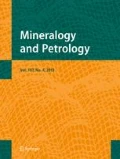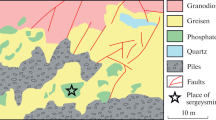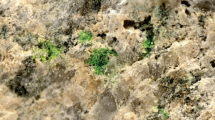Abstract
Parádsasvárite (IMA No. 2012-077) was found in the Nagy-Lápafő area, Parádsasvár, Mátra Mountains, Hungary. It forms pale beige, globular aggregates up to 0.2 mm in diameter on calcite. Associated secondary minerals are smithsonite, hemimorphite, hydrozincite, aurichalcite and rosasite. The mineral was formed as an alteration product of sphalerite and chalcopyrite in a carbonate-rich environment. Parádsasvárite is translucent with a weakly vitreous, dull or silky lustre and white streak. Its Mohs hardness is about 2–3, cleavage and parting were not observed. It is brittle; the fracture is finely fibrous. Average of nine electron-microprobe analyses gave ZnO 58.08, CuO 12.60, PbO 1.27, CO2 (calc.) 19.50, H2O (calc.) 7.94, total 99.39 wt.%, corresponding to the empirical formula (Zn0.62Cu0.36Pb0.01)Σ0.99Zn1.00(CO3)(OH)2. The seven strongest lines in the X-ray powder diffraction pattern are [dhkl in Å (Iobs %, hkl)] 6.054 (67, 200), 5.085 (100, 210), 3.703 (87, 310 and 220), 3.021 (25, 400 and 130), 2.971 (25, −211 and 001), 2.603 (62, −221) and 2.539 (36, 420). According to its X-ray powder diffraction data and chemical formula, parádsasvárite belongs to the malachite-rosasite group and it is isostructural with rosasite. It is monoclinic, space group P21/a, a = 12.92(1), b = 9.372(7), c = 3.159(4) Å, β = 110.4(1)°, V = 358.5(5) Å3, Z = 4.





Similar content being viewed by others
References
Anthony JW, Bideaux RA, Bladh KW, Nichols MC (2003) Handbook of mineralogy. Vol. V: Borates, carbonates, sulfates. Mineral Data Publishing, Tucson
Deliens M, Piret P (1980) La kolwézite, un hydroxycarbonate de cuivre et de cobalt analogue à la glaukosphaerite et à la rosasite. Bull Minéral 103:179–184
Eby RK, Hawthorne FC (1993) Structural relations in copper oxysalt minerals. I. Structural hierarchy. Acta Crystallogr B49:28–56
Fehér B, Szakáll S, Bigi S (2008) Minerals of the rosasite-zincrosasite series from the Andrássy-I. mine, Rudabánya, Hungary: the zincrosasite problem [abstract]. Mineral Spec Pap 32:65
Frost RL, Wain DL, Martens WN, Reddy BJ (2007a) The molecular structure of selected minerals of the rosasite group – an XRD, SEM and infrared spectroscopic study. Polyhedron 26:275–283
Frost RL, Wain DL, Martens WN, Reddy BJ (2007b) Vibrational spectroscopy of selected minerals of the rosasite group. Spectrochim Acta A66:1068–1074
Holland TJB, Redfern SAT (1997) Unit cell refinement from powder diffraction data: the use of regression diagnostics. Mineral Mag 61:65–77
IMA (2014) The new IMA list of minerals. Updated: March 2014. Downloaded as a pdf file from the web site http://pubsites.uws.edu.au/ima-cnmnc/ on July 21, 2014
Ivanov OK, Malinovsky YA, Mozzherin YV (1984) Pokrovskite Mg2[CO3(OH)2] • 0.5H2O – a new mineral from the Zlatogorskaya layered intrusive (Kazakhstan). Zap Vses Mineral Obshch 113:90–95 (in Russian)
Kiss J (1960) A new ore occurrence in the environment of Nagygalya-Nagylipót-Aranybányafolyás (Mátra Mountains, NE-Hungary). Ann Univ Sci Bp Rolando Eötvös Nomin Sect Geol 3:55–81
Kiss J (1964) Allitic and siallitic minerals and their role in the ore mineralization of the central part of the Mátra Mountains, N-Hungary. Földt Közl 94:422–431 (in Hungarian with French abstract)
Koch S (1966) Minerals of Hungary. Akadémiai Kiadó, Budapest (in Hungarian)
Kraus W, Nolze G (1996) Powder Cell – a program for the representation and manipulation of crystal structures and calculation of the resulting X-ray powder patterns. J Appl Crystallogr 29:301–303
Libowitzky E (1999) Correlation of O-H stretching frequencies and O-H···O hydrogen bond lengths in minerals. Monatsh Chem 130:1047–1059
Lovisato D (1908) Rosasite, nuovo minerale della miniera di Rosas (Sulcis, Sardegna). Atti R Accad Lincei Cl Sci Fis Mat Nat 17:723–728
Mandarino J (1981) The Gladstone-Dale relationship: part IV. The compatibility concept and its application. Can Mineral 19:441–450
Nickel EH, Berry LG (1981) The new mineral nullaginite and additional data on the related minerals rosasite and glaukosphaerite. Can Mineral 19:315–324
Pauliš P, Novák F, Janák P (2005) Serpierite and zincrosasite from Herlíkovice near the town of Vrchlabí (Czech Republic). Opera Corcon 42:73–77 (in Czech with English abstract)
Pekov IV, Perchiazzi N, Merlino S, Kalachev VN, Merlini M, Zadov AE (2007) Chukanovite, Fe2(CO3)(OH)2, a new mineral from the weathered iron meteorite Dronino. Eur J Mineral 19:891–898
Perchiazzi N (2006) Crystal structure determination and Rietveld refinement of rosasite and mcguinnessite. Z Krist Suppl 23:505–510
Perchiazzi N, Merlino S (2006) The malachite-rosasite group: crystal structures of glaukosphaerite and pokrovskite. Eur J Mineral 18:787–792
Pouchou L, Pichoir F (1984) A new model for quantitative X-ray microanalysis. Res Aerosp 3:167–192
Roberts AC, Jambor JL, Grice JD (1986) The X-ray crystallography of rosasite from Tsumeb, Namibia. Powder Diffract 1:56–57
Rónai A, Pelikán P (2005) Geological map of Hungary. L-34-4 Gyöngyös, 1:100 000. Geological Institute of Hungary, Budapest (in Hungarian)
Strunz H (1959) Tsumeb, seine Erze und Sekundärmineralien, insbesondere der neu aufgeschlossenen zweiten Oxydationszone. Fortschr Mineral 37:87–90
Strunz H, Nickel EH (2001) Strunz mineralogical tables, 9th edn. E. Schweizerbart’sche Verlagsbuchhandlung, Stuttgart
Zelensky ME, Matseevsky AB, Pekov IV (2009) The computer program QSpectr for processing X-ray powder diffraction films obtained from the Debye-Scherrer camera. Zap Ross Mineral Obshch 138(4):103–112 (in Russian with English abstract)
Zigan F, Joswig W, Schuster HD (1977) Verfeinerung der Struktur von Malachit, Cu2(OH)2CO3, durch Neutronenbeugung. Z Krist 145:412–426
Acknowledgments
We thank Sándor Klaj (Pécs) for providing of the holotype sample and László Tóth (Velence) for the high quality photomicrograph of parádsasvárite. We also acknowledge Philip Rawlinson (Corvinus University, Budapest) for the English text revision. Finally, the authors would like to thank the two anonymous reviewers, as well as the Associate Editor Anton Beran for their valuable comments and suggestions to improve the manuscript.
Author information
Authors and Affiliations
Corresponding author
Additional information
Editorial handling: A. Beran
Rights and permissions
About this article
Cite this article
Fehér, B., Szakáll, S., Zajzon, N. et al. Parádsasvárite, a new member of the malachite-rosasite group from Parádsasvár, Mátra Mountains, Hungary. Miner Petrol 109, 405–411 (2015). https://doi.org/10.1007/s00710-015-0370-x
Received:
Accepted:
Published:
Issue Date:
DOI: https://doi.org/10.1007/s00710-015-0370-x




